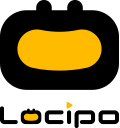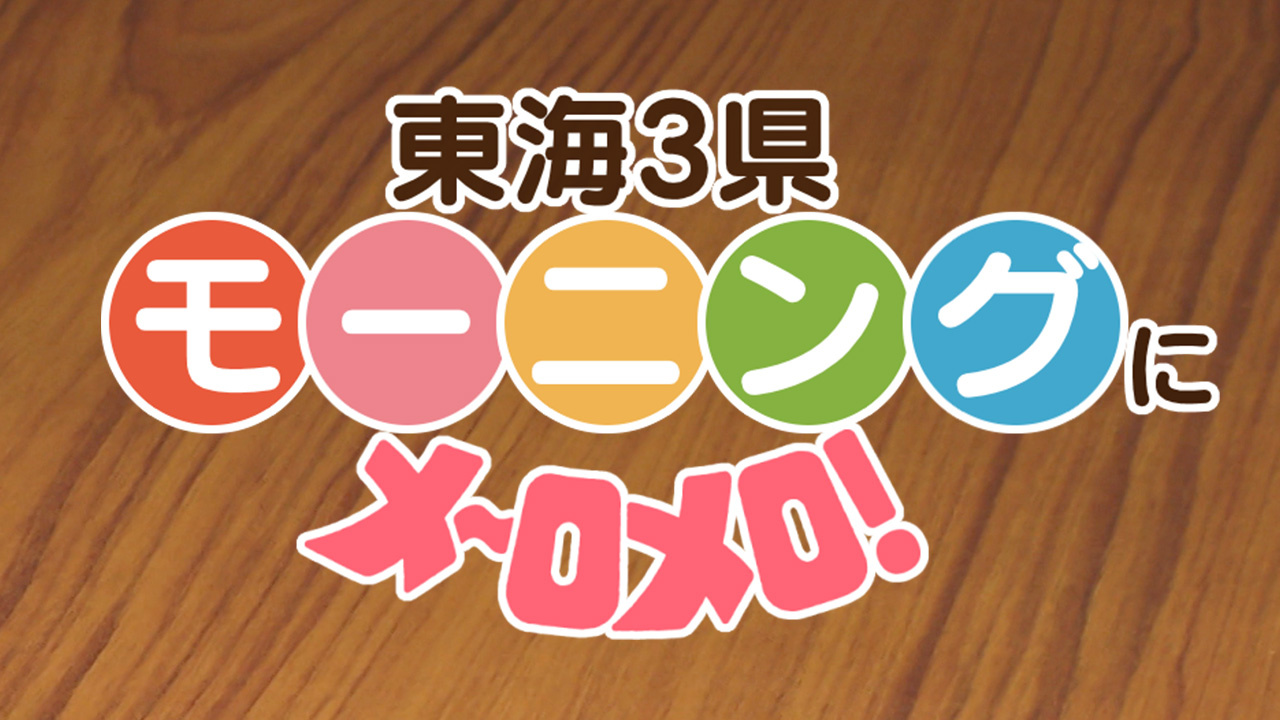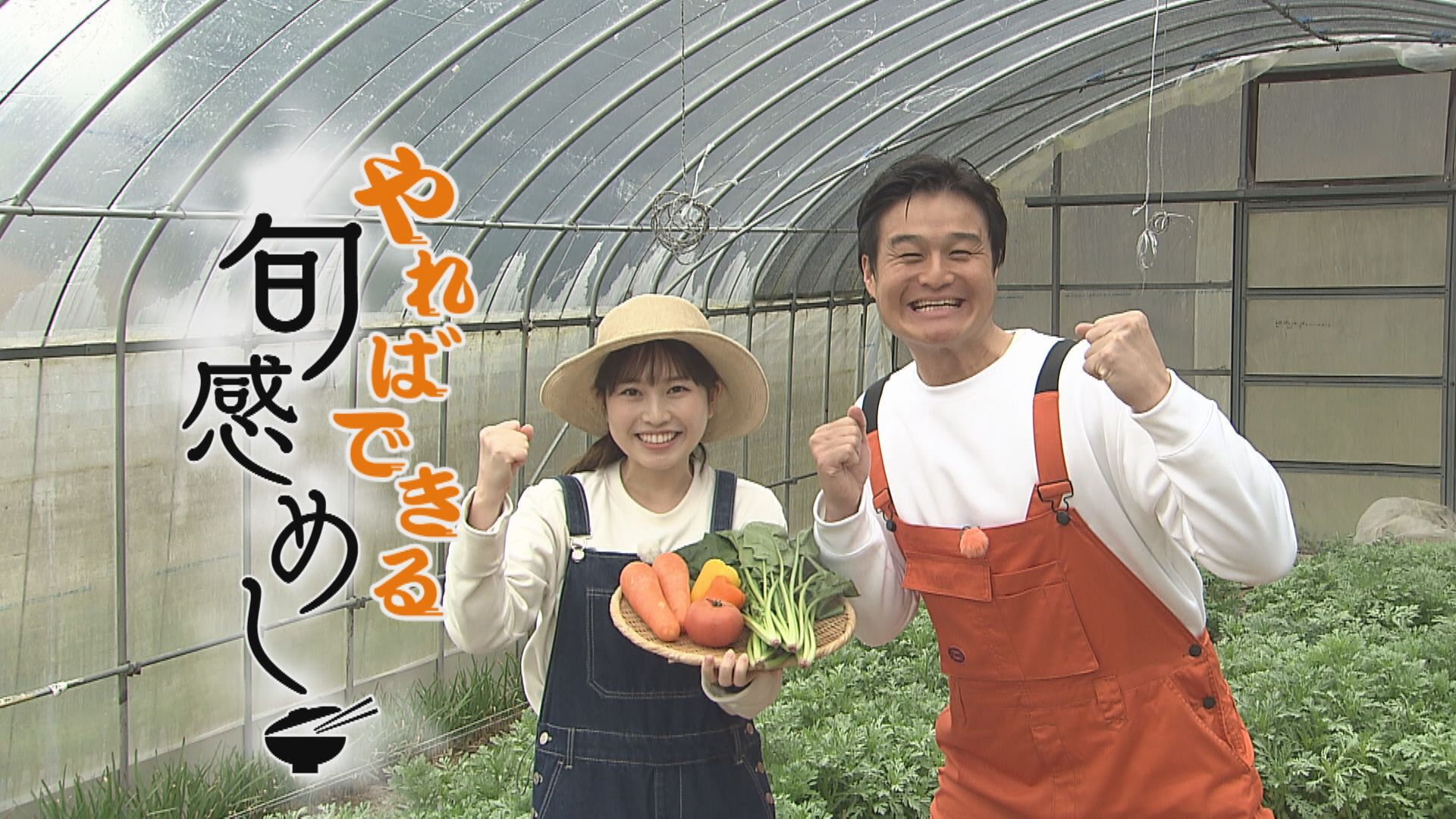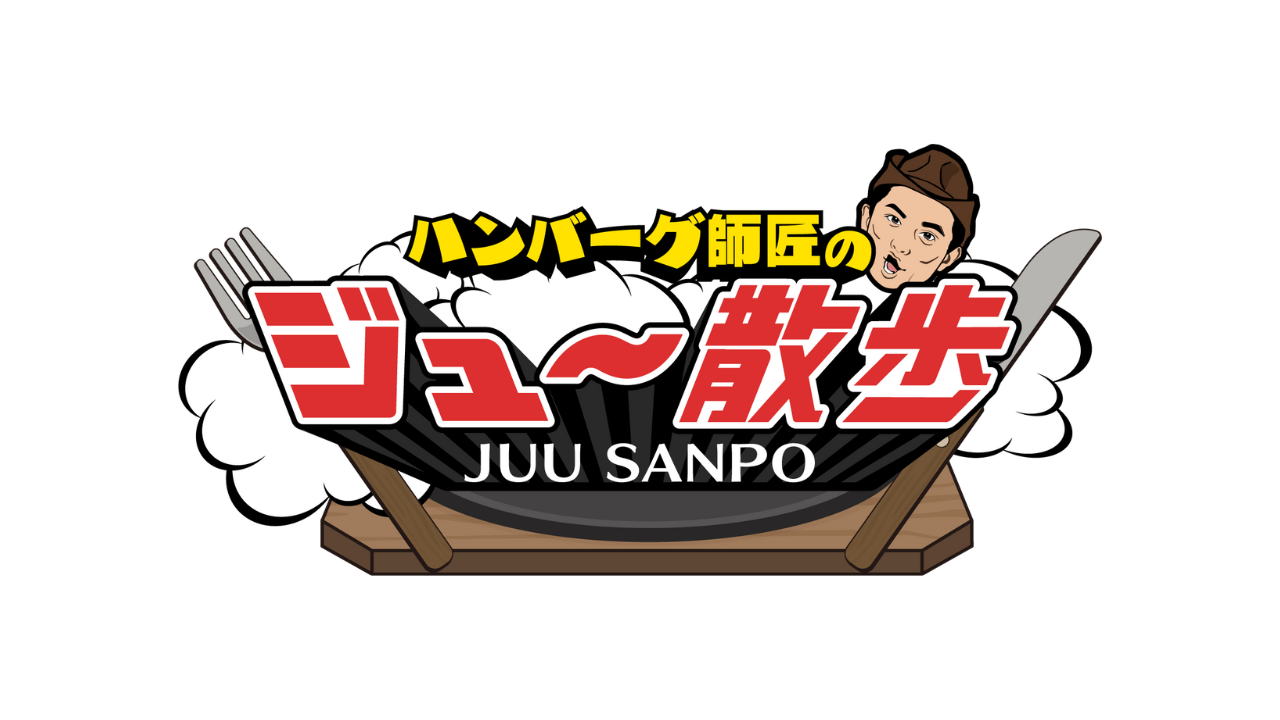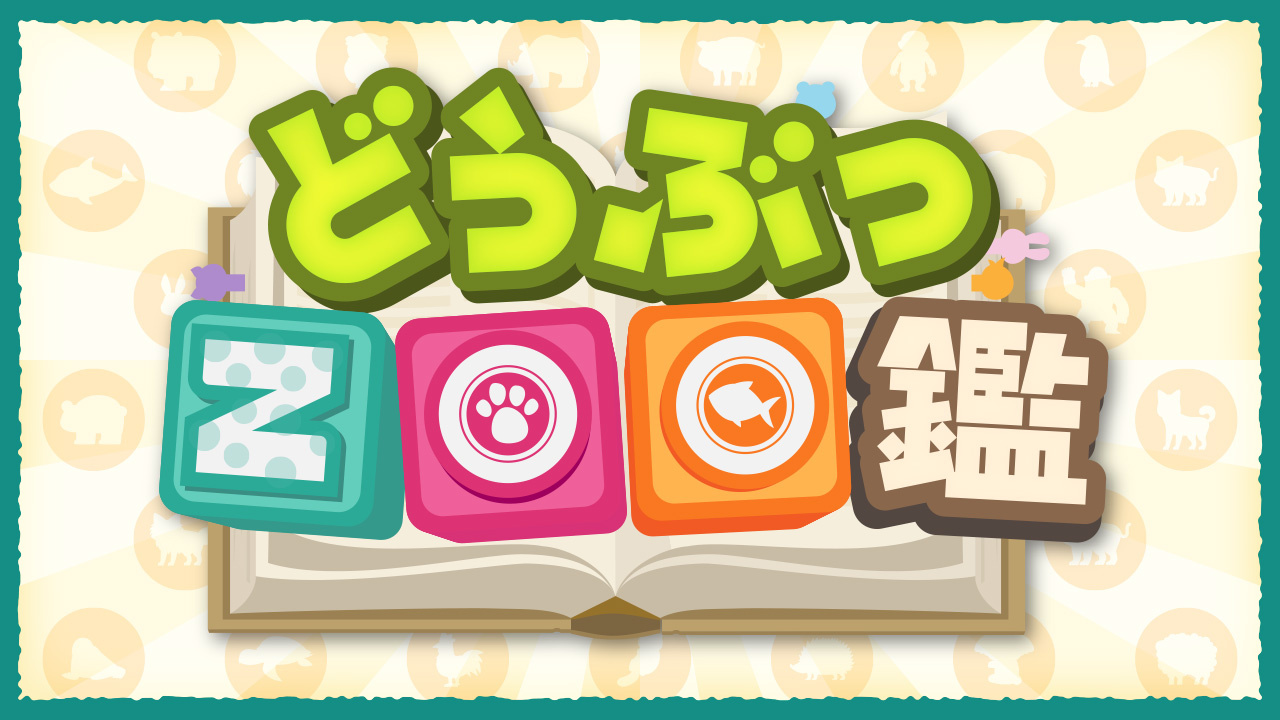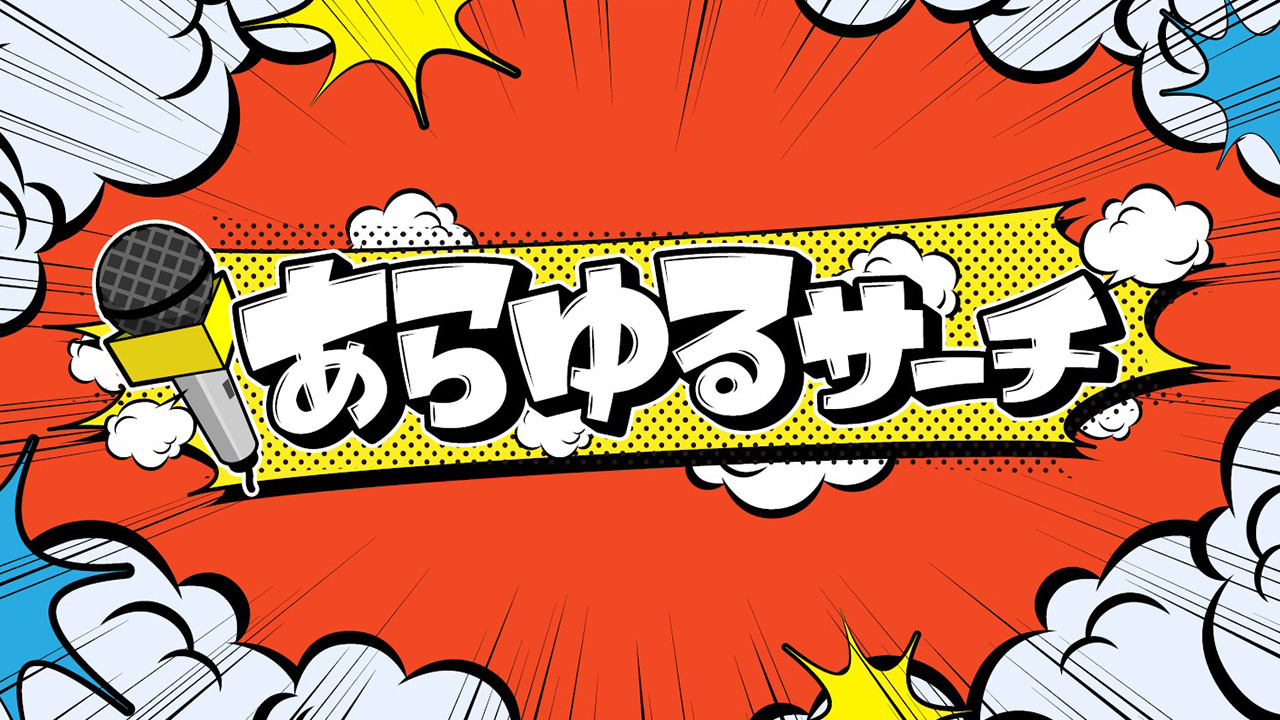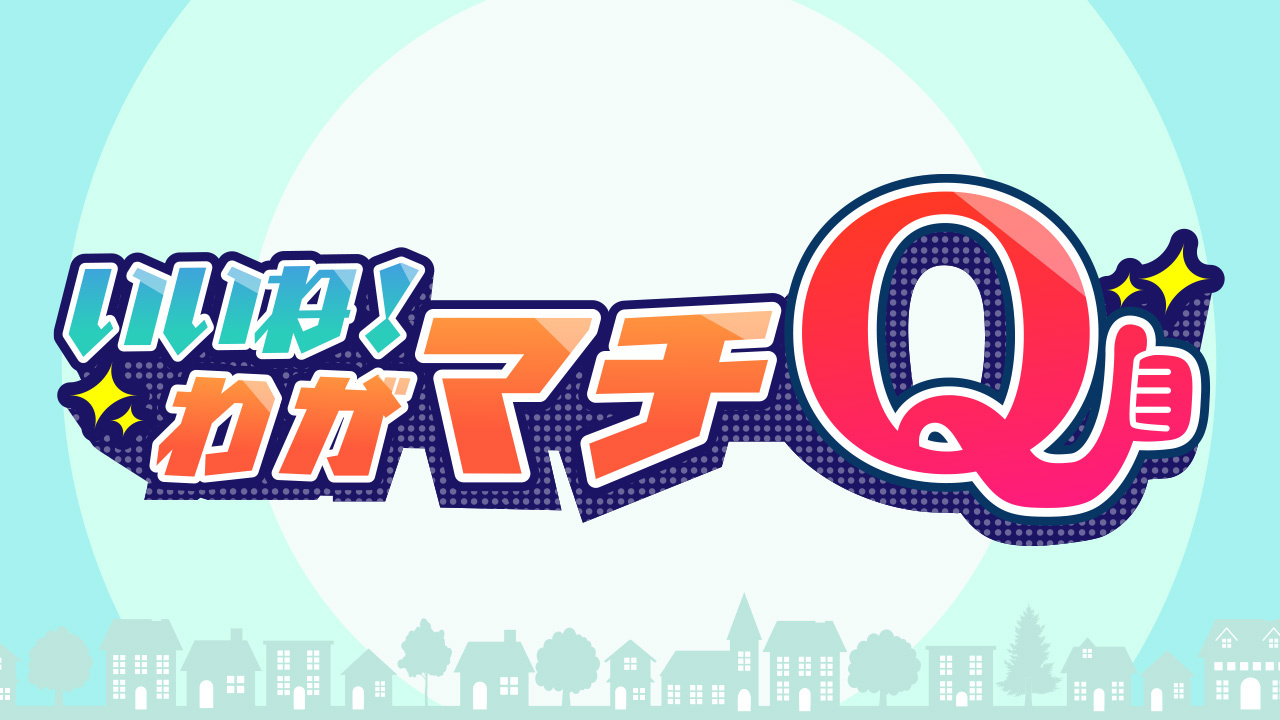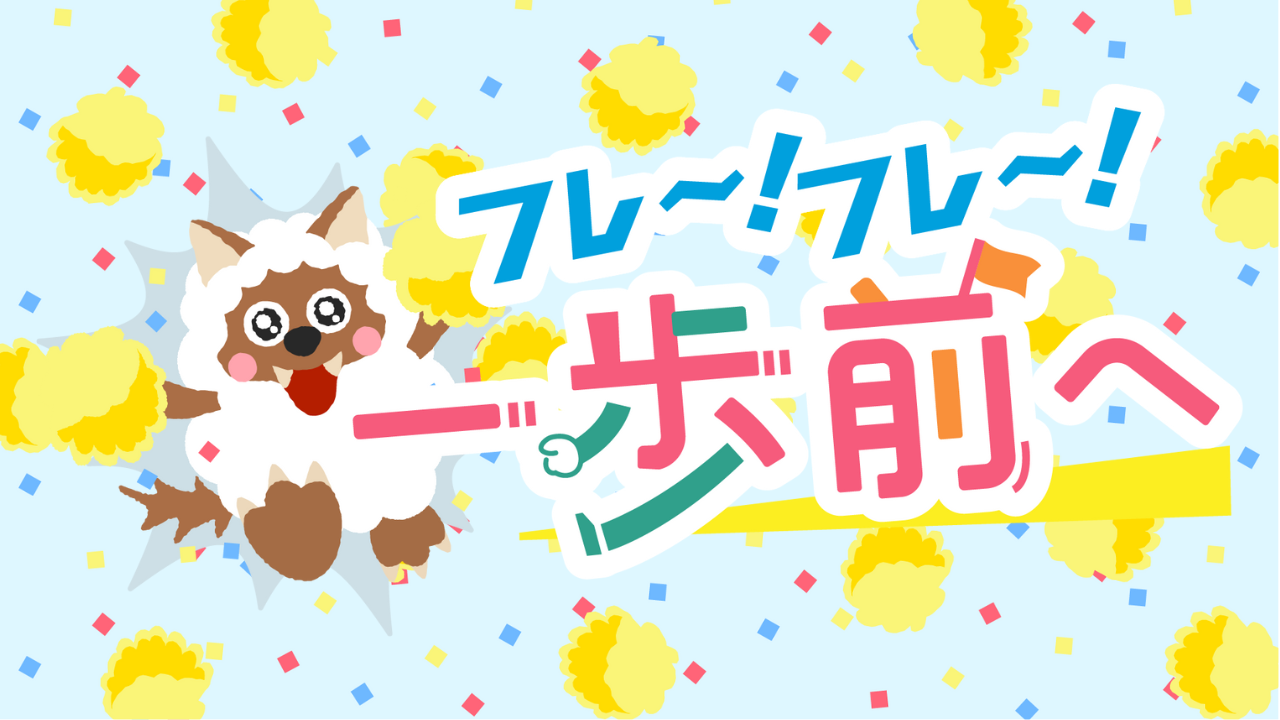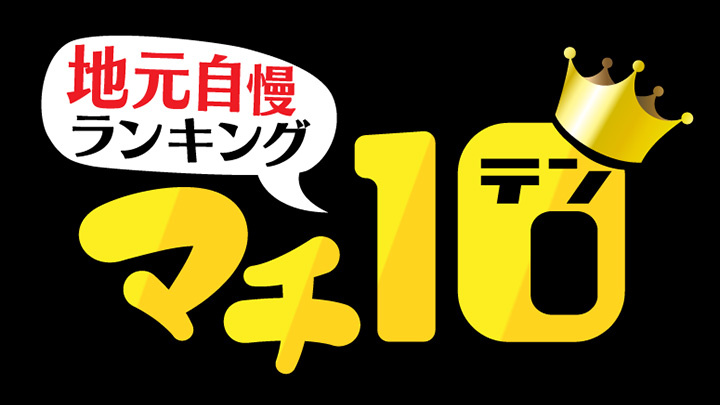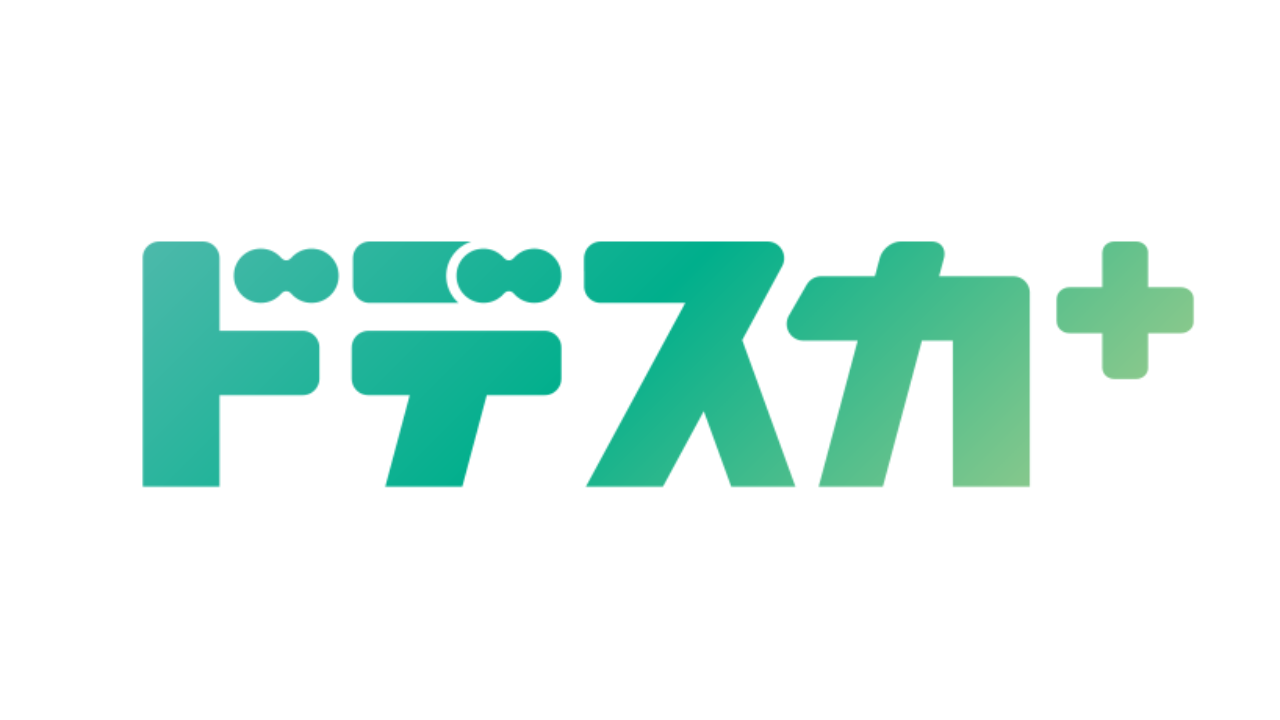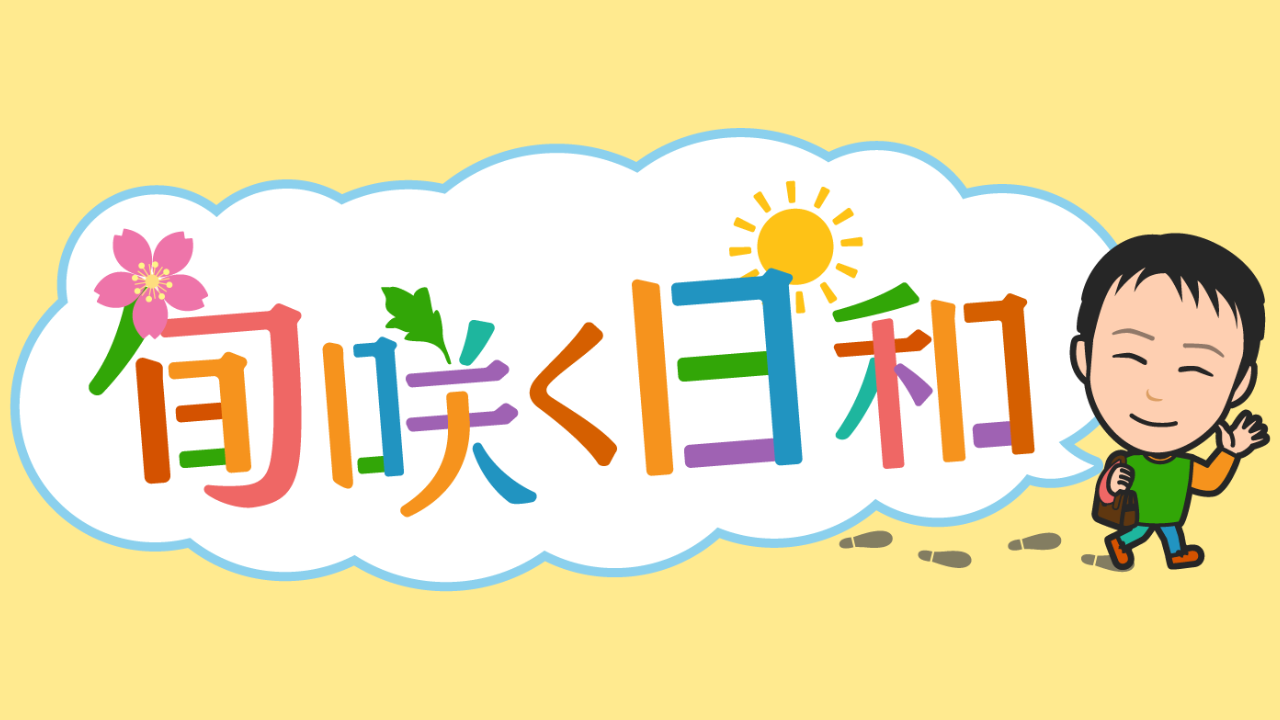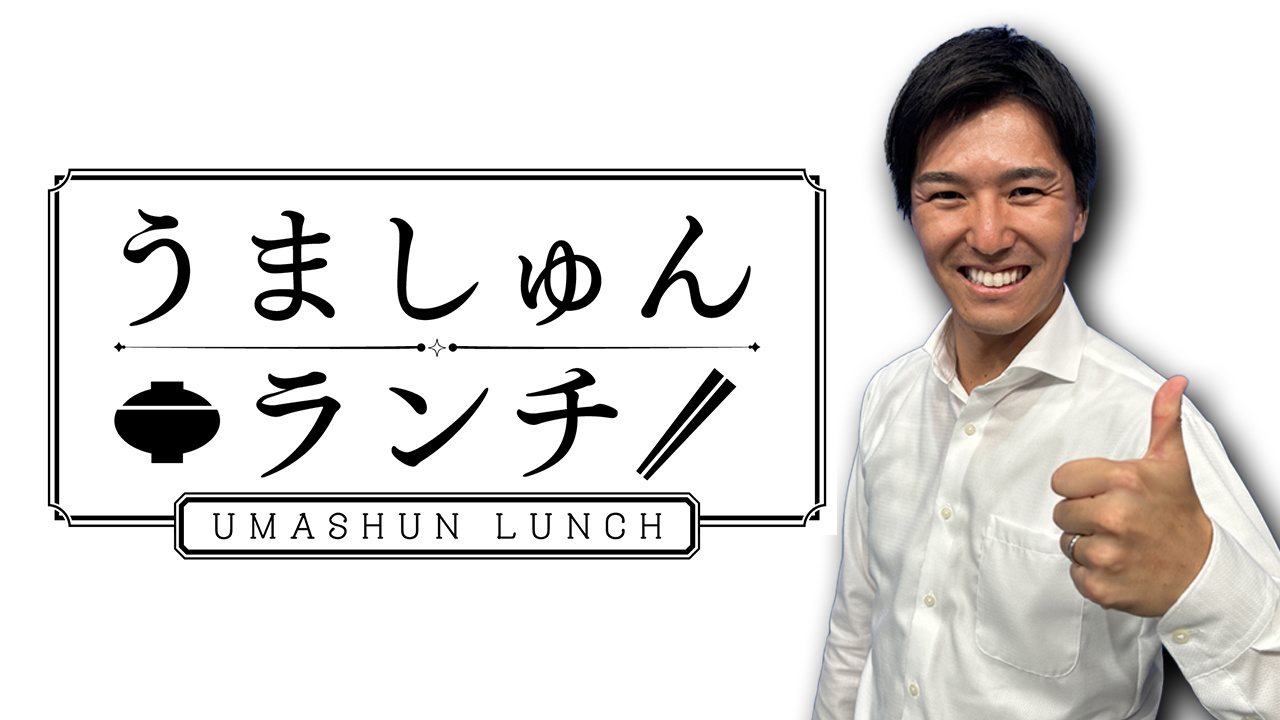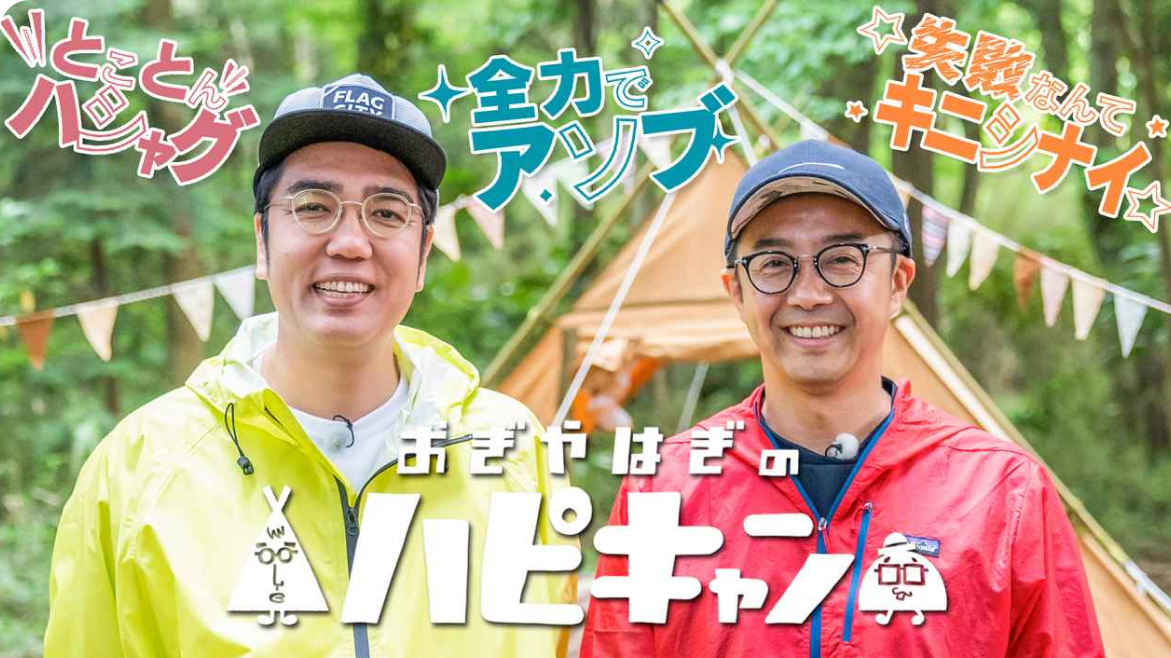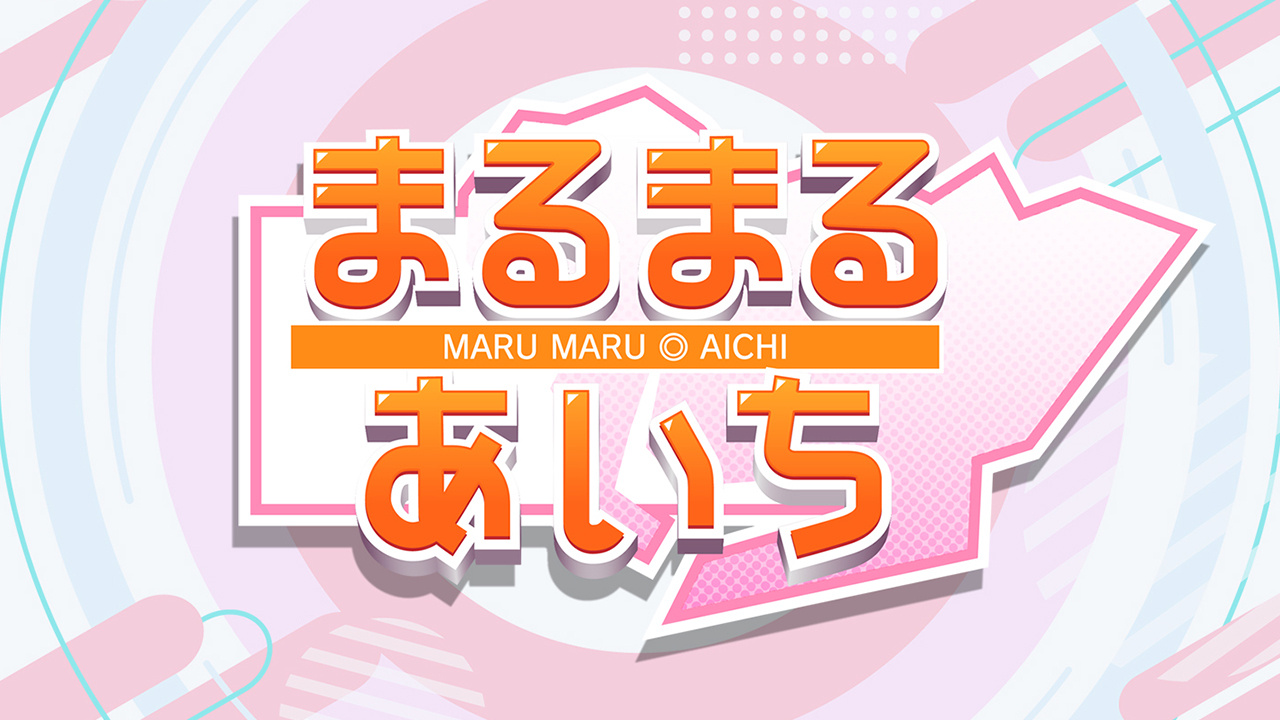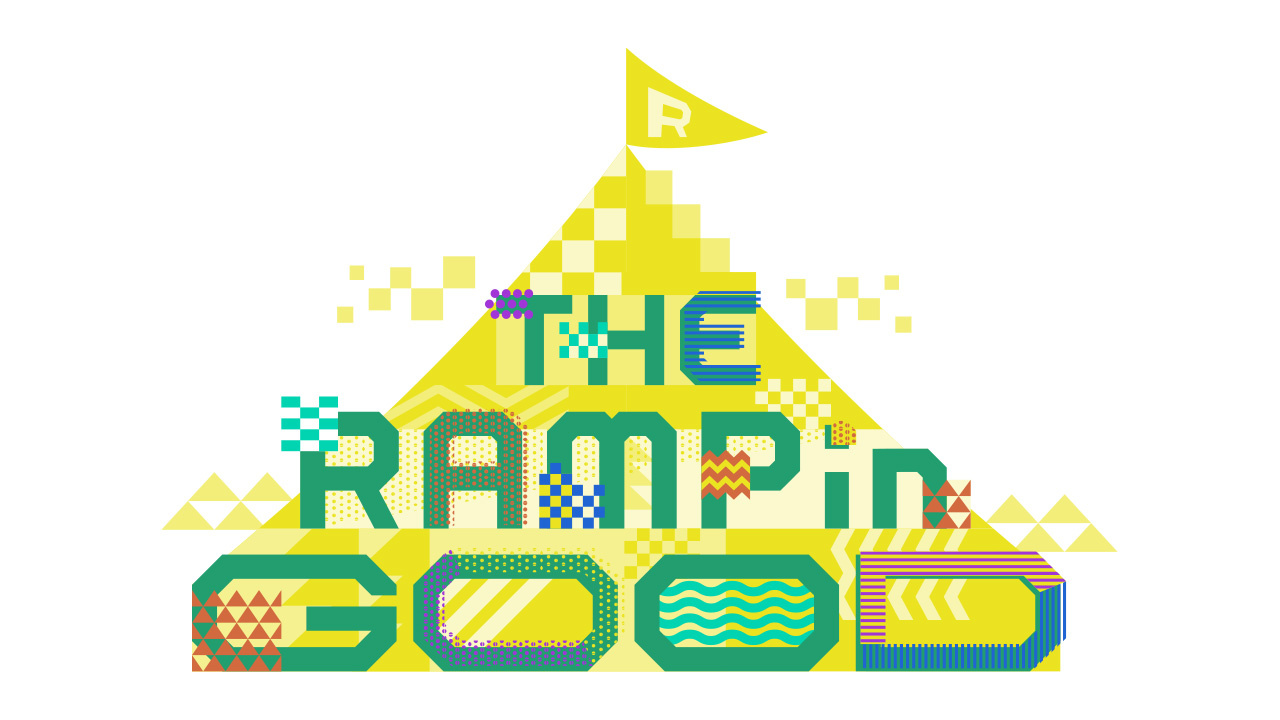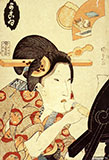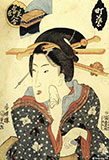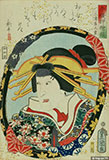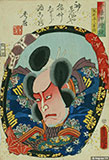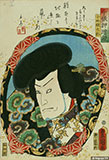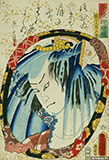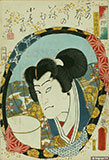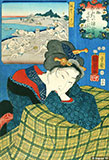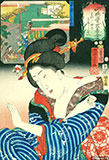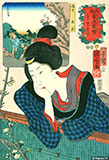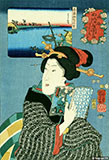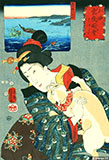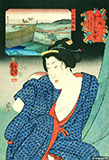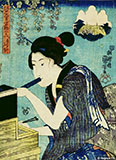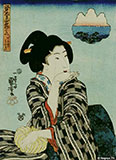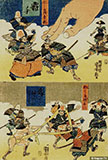歌川国定・歌川国芳 展示場
Room of Kunisada Utagawa & Kuniyoshi Utagawa
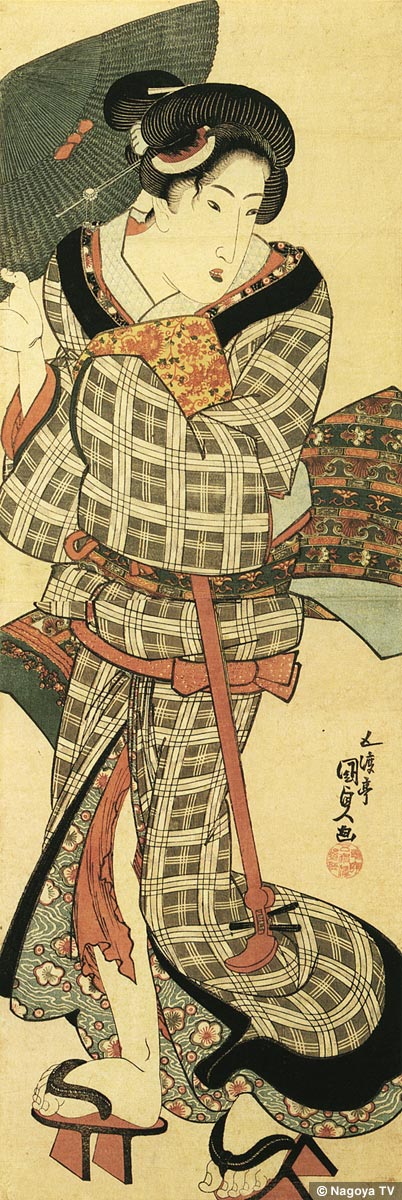
1.鳥追い美人
The beautiful bird catcher
歌川国貞 KUNISADA
害鳥を追い払う祈願をして家々をまわるのが鳥追(とりおい)。江戸の町方では、編み笠の女性が三味線(と胡弓) を携え、正月に各戸を回った。
The bird catchers go around to each house offering prayers that will drive away birds that are hazardous to crops. In the town of Edo, a woman With a boraided hat and shamisen (and Chinese fiddle) would go around door-to-door during the New Year.
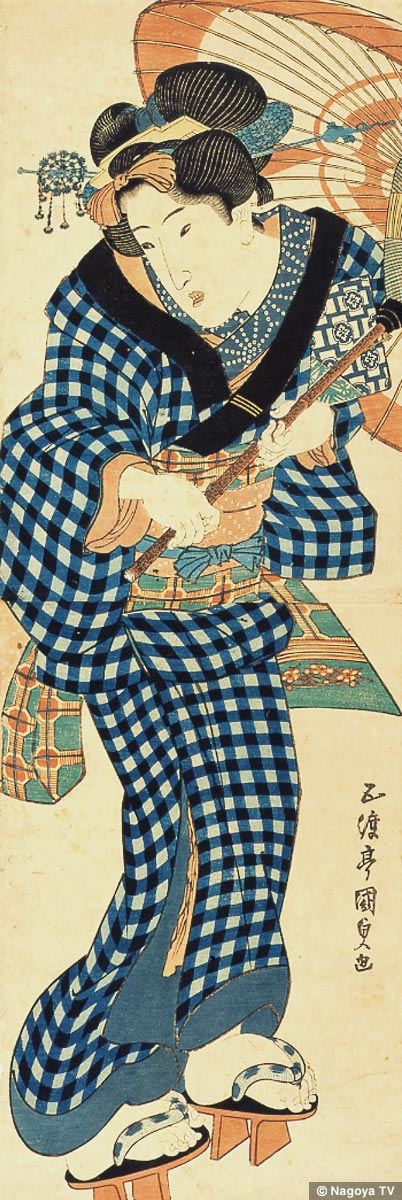
2.からかさ美人
Beauty with a bamboo unbrella
歌川国貞 KUNISADA
太判 (B4程度の大きさ)の紙を2枚縦につないだ掛物絵版は、実際に掛け軸の代わりに用いられた。藍の格子縞の着物が粋である
Two large size sheets of paper are vertically attached to make a hanging print, which was actually used in place of a hanging scroll. The deep blue plaid kimono is elegant.
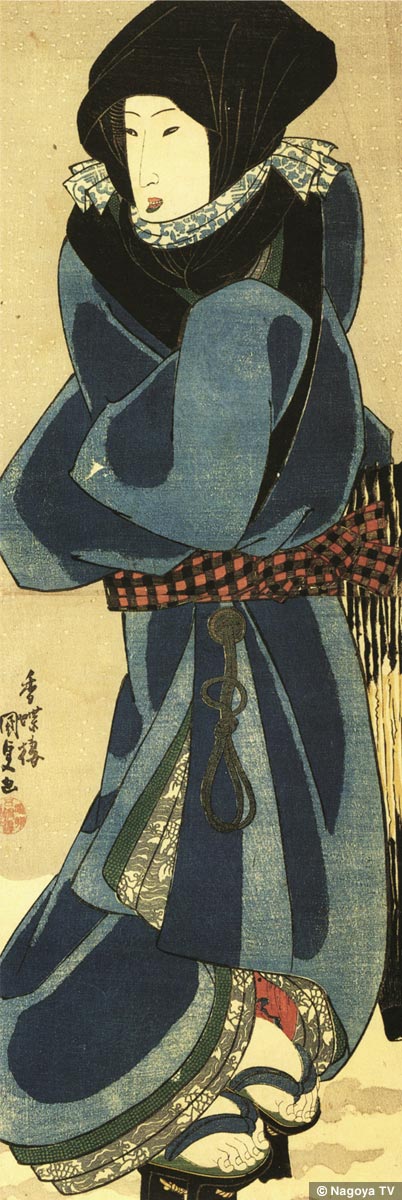
3.藍染め美人
Beauty with a dark blue died kimono
歌川国貞 KUNISADA
黒い頭巾(ずきん)をかぶり、藍一色の着物を着た女性が、雪の中を歩く姿が描かれる。背景の曇り空や、積もった白い雪に、藍色が引き立ち、まことに粋である。
A woman walking through the snow with a black kerchief on her head and wearing a deep blue kimono is being depicted. The cloudy sky in the background and the cumulated snow brings out the deep blue color. It is truly elegant.
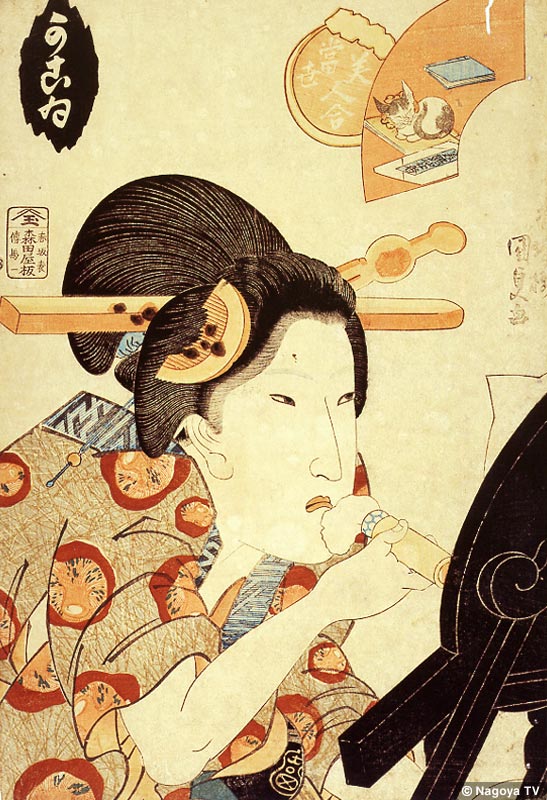
4.当世美人合 かこゐ
Kakoi, from the series: "The modern day beauty"
歌川国貞 KUNISADA
「かこゐ」は別宅に住まわせておくめかけのこと。国貞が「かこゐ」にこめたイメージをとくと読みとっていただきたい。
A "Kakoi" is a concubine that is kept in a separate house. Try to perceive the image that Kunisada has portrayed through this "Kakoi."
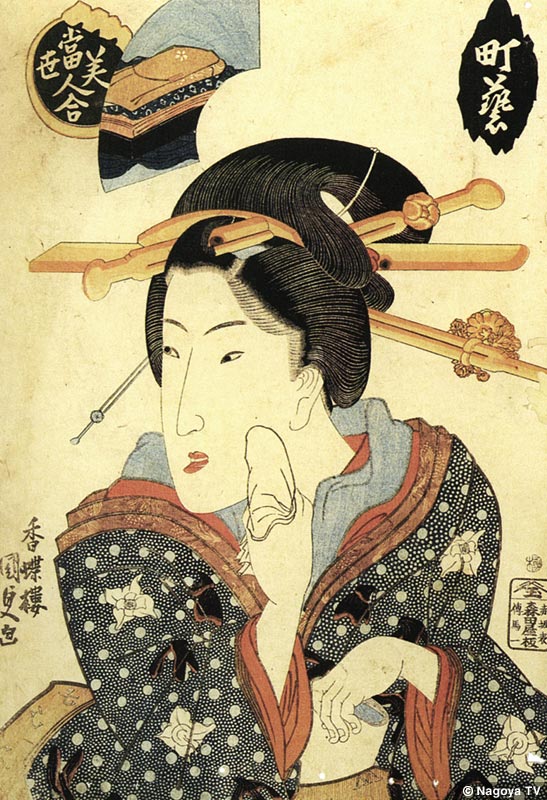
5.当世美人合 町芸
Machigei, from the series: "The modern day beauty"
歌川国貞 KUNISADA
「町芸」は町芸者のこと。郭 (くるわ)にいる芸者に対して、町に住む芸者をいう。扇の中の絵は判じ絵。おそらく女性の名が隠されているはずである。
A "Machigei" is a Machi (town) geisha. They live in the town, rather than in the confines of a house. The picture in the fan is a pictorial puzzle. The woman's name is likely to be hidden somewhere.
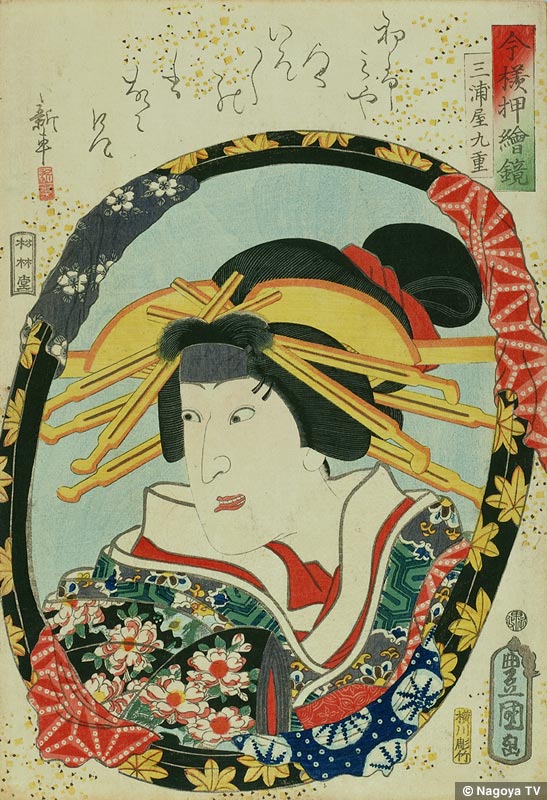
6.今様押絵鏡 三浦屋九重
Kokonoe ut Miuraya, from the series: "Modern mirror printis"
歌川国貞 KUNISADA
今様押絵鏡は、三代豊国を名乗った国貞の晩年の大部な揃物。蒔絵の縁のある鏡に写ったように役者の姿絵をえがいたもの。力ラフルな外題簽の脇に役名が書かれる。
In the late years of his life the mass collection of Modern Mirror Prints belonged to Kunisada, who referred to himself as Toyokuni the Third. It is a depiction of an actor the way it would be reflected through the mirror in the rim of the lacquer. The actor's name is written in the colorful long and narrow slip of paper.
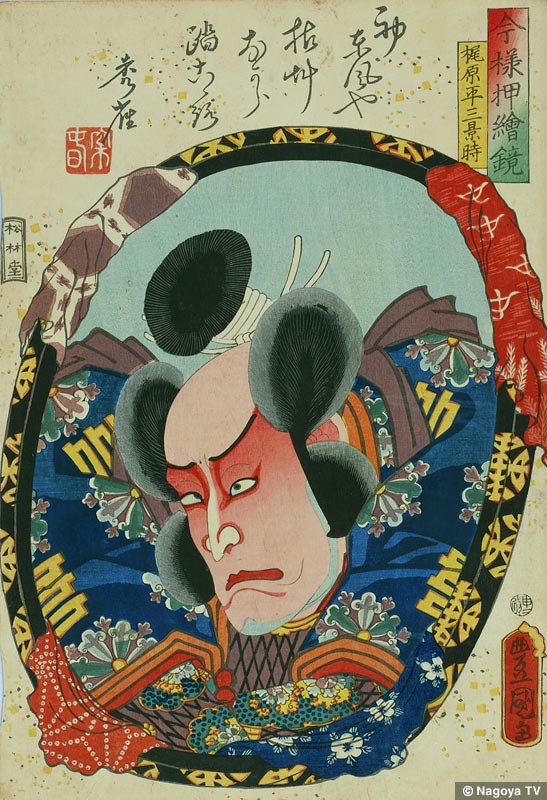
7.今様押絵鏡 梶原平三景時
Kajiwara Heizoukagetoki, from the series: "Modern mirror printis"
歌川国貞 KUNISADA
幕末は摺の技術も最高潮を迎えようとする時期 であった。髪の毛を細かに表現するいわゆる毛彫りなど、驚くべき技術が発揮される。
The end of the Edo Period was also the climatic point of print making techniques. Amazing techniques were exhibited, such as the technique that is reffered to as "hariline engraving," which is used to express thin lines of hair.
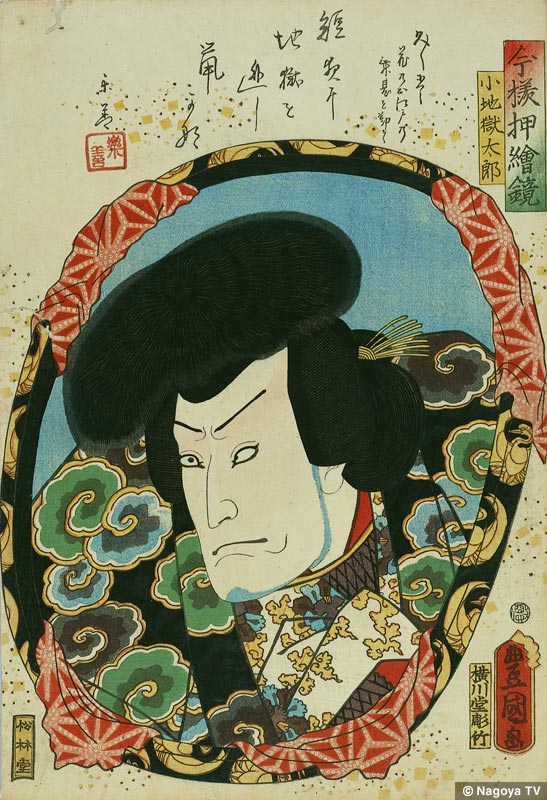
8.今様押絵鏡 小池獄太郎
Koike Gokutaro, from the series: "Modern mirror printis"
歌川国貞 KUNISADA
鏡の上に書かれる句は、それぞれ役者の作。最後に役者の俳名が記されている。役者はみな教養豊かであったことが分かる。
The Haiku above the mirrors are each actor's works. Each actor's artist name is written at the end. We can tell that all the actors were culturally immersed.
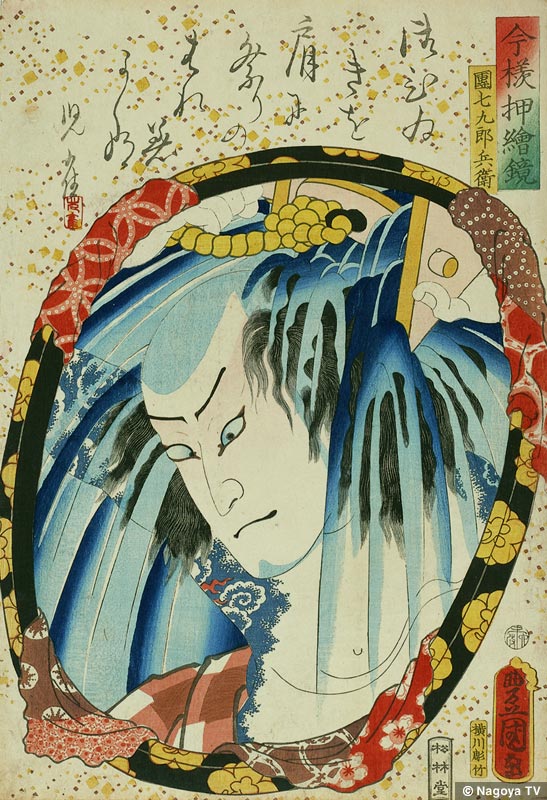
9.今様押絵鏡 団七九郎兵衛
Danshichi Kurobee, from the series: "Modern mirror printis"
歌川国貞 KUNISADA
晩年の国貞の役者絵は、赤と緑という補色関係にある色同士など、組み合わせによってはどぎつく下品になりそうな色をうまく使い、鮮烈な色彩効果を出すことに成功している。
The actor prints from the later years in Kunisada's life, use complementary colors such as red and green which, depending on the combination, are usually quite tasteless but Kunisada succeeded at creating a new color effect.
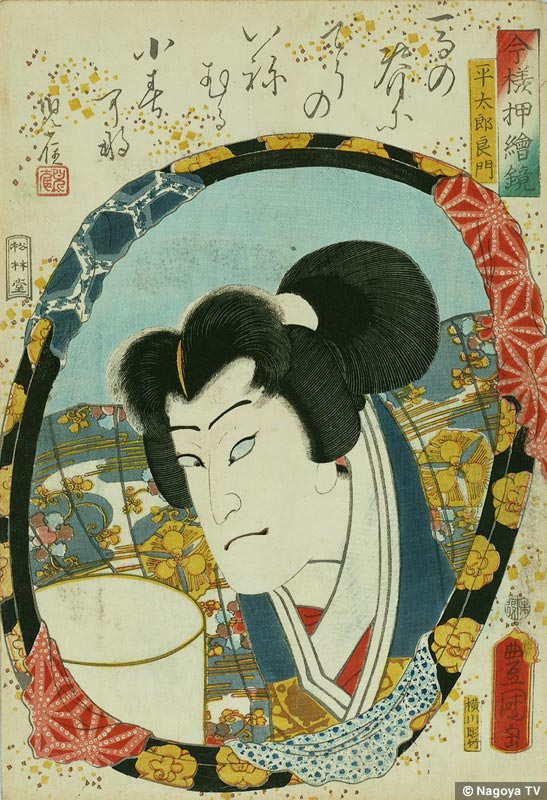
10.今様押絵鏡 平太郎良円門
Heitaro Yoshikado, from the series: "Modern mirror printis"
歌川国貞 KUNISADA
当時の江戸の人にとって芝居は、楽しみの中心的なものであり、似顔絵に描かれた役者は、役者名が記されなくとも、わかったものである。今日のイチローのように。
During these days the theater was the center of entertainment for people. Even if the actor's name was not written on the portrait, people would know who it was; like Ichiro today.
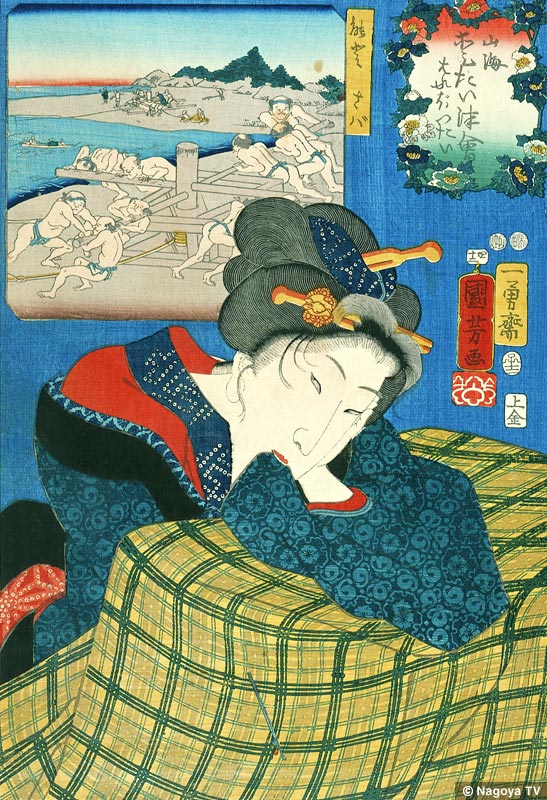
11.山海愛度図会 はれぼったい能登さバ
Puffy. Noto mackerel, from the series: "Appreciation for the land and the sea"
歌川国芳 KUNIYOSHI
女性が「○○したい」という題に見合ったポーズをとり、こま絵には各地の名産と地名が描かれる。こま絵は国芳の子女門弟が担当している。
The woman would strike a pose that fit the title, "I want to・・・" and specialty products, along with their geographical name of association, were depicted on these koma-e (small cut pictures). Kuniyoshi's disciple was in charge of these Koma-e.
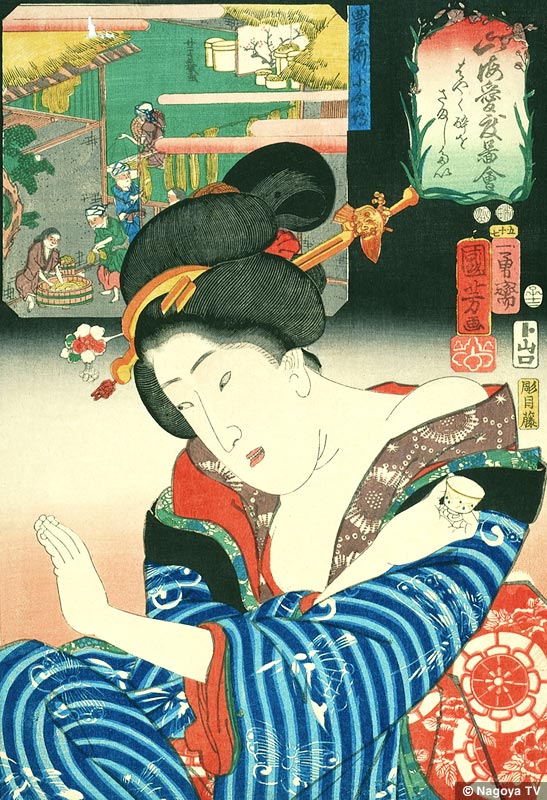
12.山海愛度図会 はやく酔をさましたい豊前小倉縞
Wanting to sober up, from the series: "Appreciation for the land and the sea"
歌川国芳 KUNIYOSHI
まだ飲ませようとするのを、ことわる体である。無理強いはいけません。本シリーズ、描かれる女性の心理描写に注目したいものである。
More alchohol is being offered even though she is trying to refuse. It is not good to force pressure. It is important to pay attention to the psychological descriptions of the women in this series.
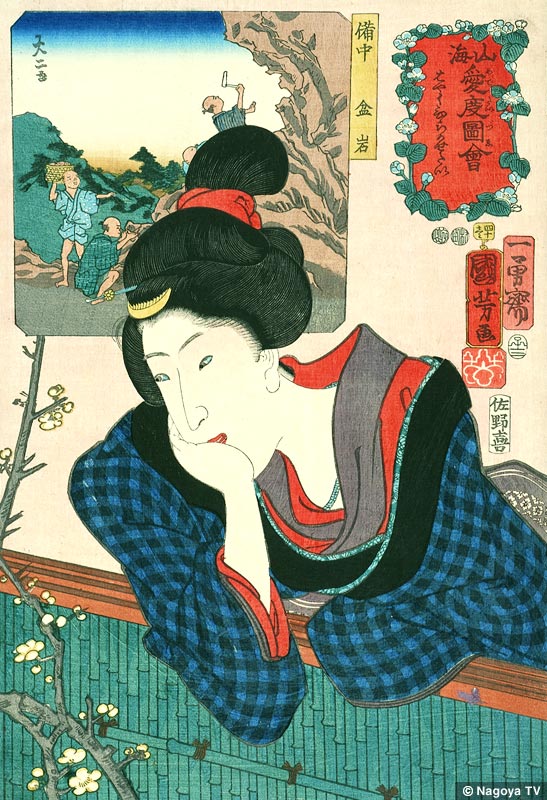
13.山海愛度図会 はやくひらかせたい備中盆岩
Wanting to open Bom-stone im Bicchu Province, from the series: "Appreciation for the land and the sea"
歌川国芳 KUNIYOSHI
梅の花の開くのを待つ女性の姿である。国芳の描く女性は、微妙な色気めいたものを含みながらも健康的である。実生活でも江戸っ子気質そのものであった国芳らしいものである。
It is the sight of a woman waiting for plum blossom to flower. The women that Kuniyoshi depicts have subtle sexual appeals but all seam healthy. It is a typical work of Kuniyoshi, Who in real life was a native of Edo in disposition.
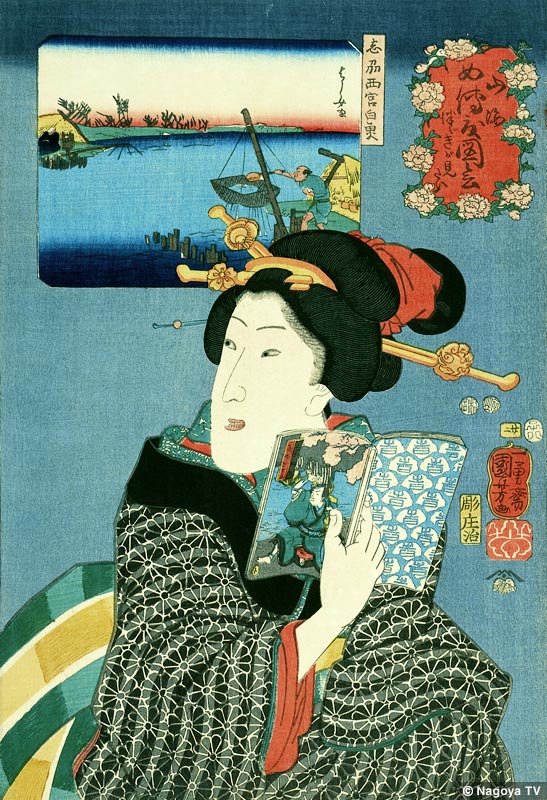
14.山海愛度図会 つづきが見たい志州西宮白魚
Wanting to see more of the ice fish at Nishinomiya in Shinano Province, from the series: "Appreciation for the land and the sea"
歌川国芳 KUNIYOSHI
これは分かり易い。子女の楽しみとして読書があったことがわかる。本の題簽には「一雄斎国芳画」、絵の落款そのままがはめ込んである。志州は志摩(三重県)である。
This is easy to understand. We see that a favorite enjoyment for women was reading. The title of the book reads "Ichiyusai Kuniyoshi Prints." The author's seal has been directly embedded. Shishu is Shima (Mie Prefecture).
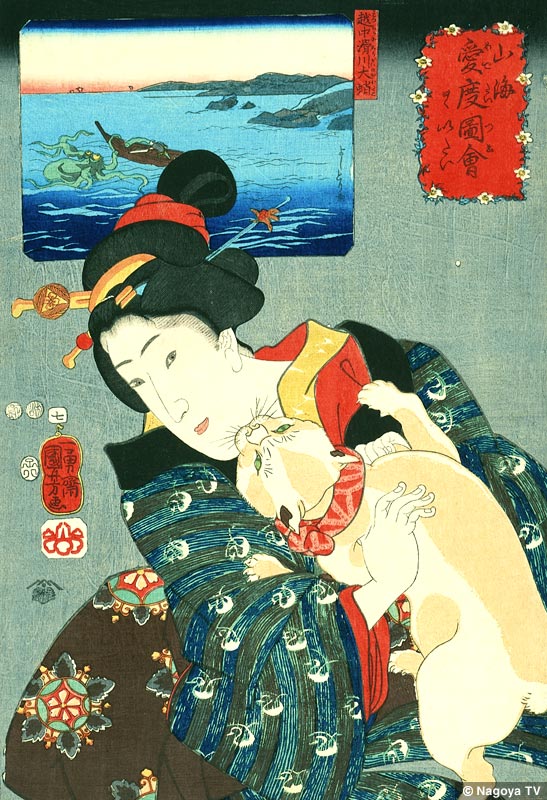
15.山海愛度図会 ヲゝいたい越中滑川大蛸
Hurting. the giant octopus from Ecchu Province, from the series: "Appreciation for the land and the sea"
歌川国芳 KUNIYOSHI
「○○したい」ではなく、語尾が通じて「痛い」である。じゃれつく猫に、しかし、いやではない。猫好きの心理。実は国芳は大の猫好き。猫を題材にした戯画は数え切れないほどある。
Instead of "I want to・・・" the ending of the word is communicated and is "ouch." The playful cat, but it is the mentality of the cat lover that doesn't mind. Kuniyoshi was actually loved cats very much. His amount of humorous prints that use cats as the subject are innumerable.
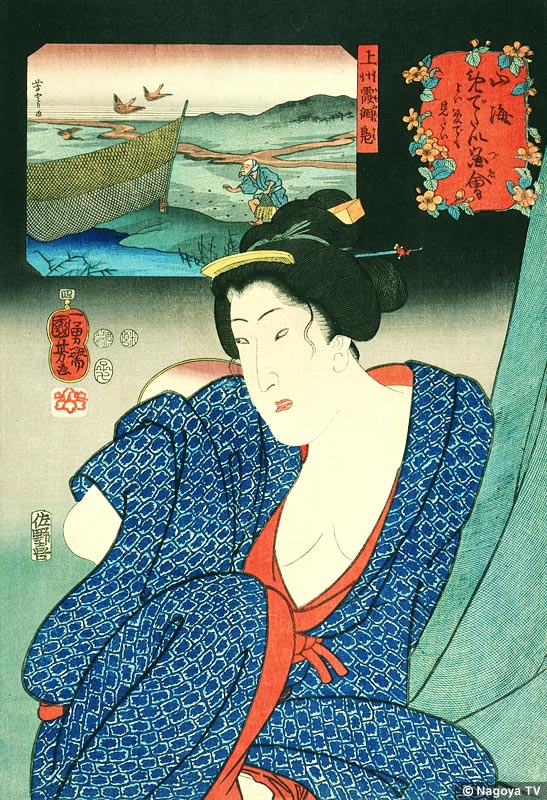
16.山海愛度図会 よい夢でも見たい上州霞網鳥
Hoping for sweet dreams, mist net for ducks in Kozuke Province, from the series: "Appreciation for the land and the sea"
歌川国芳 KUNIYOSHI
蚊帳に入るつまり、床に入るところである。何か不機嫌そうな表情であり、現実から離れて夢だけでもよくなってほしいといったところか。こま絵は霞網で鴨を捕る猟である。
Entering the mosquito net means that she is about to go to sleep. The expression seems to be one of discontent, as if wanting to escape from reality and at least have nice dream. The small cut picture is that of hunting duck with a Japanese mist net.
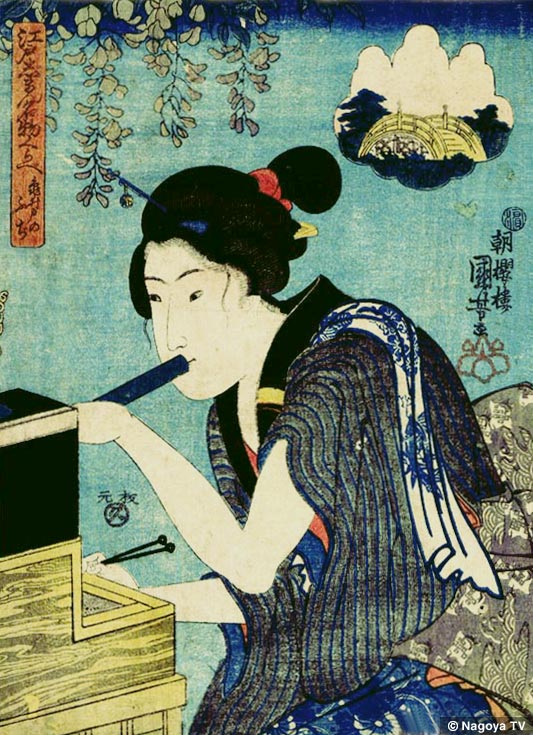
17.亀井戸のふち
Wisteria of Kameido
歌川国芳 KUNIYOSHI
亀戸天満宮の茶屋娘の姿が大きく描かれる。女は、火吹竹で火を起こしている。真剣なまなざしで頬に息を込めたその顔つきは、リアルで躍動感に満ち、邪心がないのがよい。
A large depiction of the waitress at Kamedo Tenmangu tea shop. The girl is starting a fire by blowing through bamboo stalks. She has only seriousness in her eyes and her face as she holds air in her cheeks is realistic and uplifting without a trace of evil.
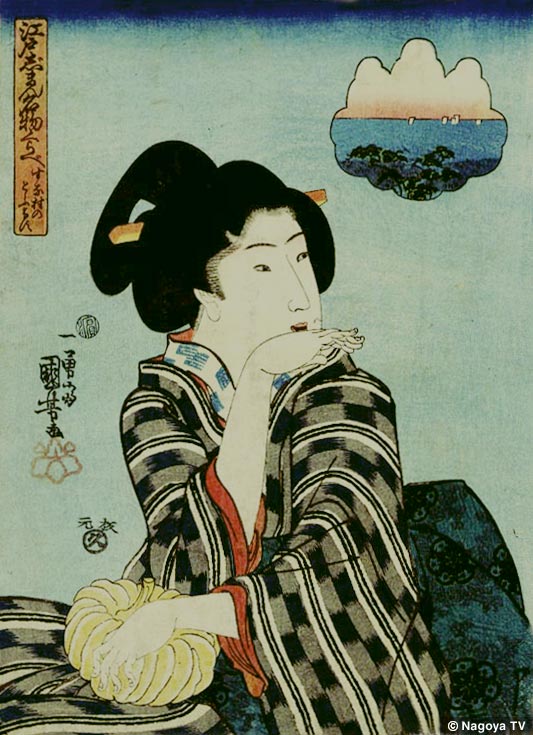
18.すな村のとふなす
A pumpkin from Suna-mura
歌川国芳 KUNIYOSHI
かつては砂村といった現在の東京都江東区砂町。そこの名産である唐茄子(とうなす)つまり南瓜 (かぼちゃ)である。女性は南瓜を抱えながら、話にふけっているようだ。
Previously Suna-mura, it is present day Koto-ku Suna-cho in Tokyo. The specialty product of the area was Tonasu, in other Words pumpkin. The woman seems to be indulged in a conversation while carrying a pumpkin.
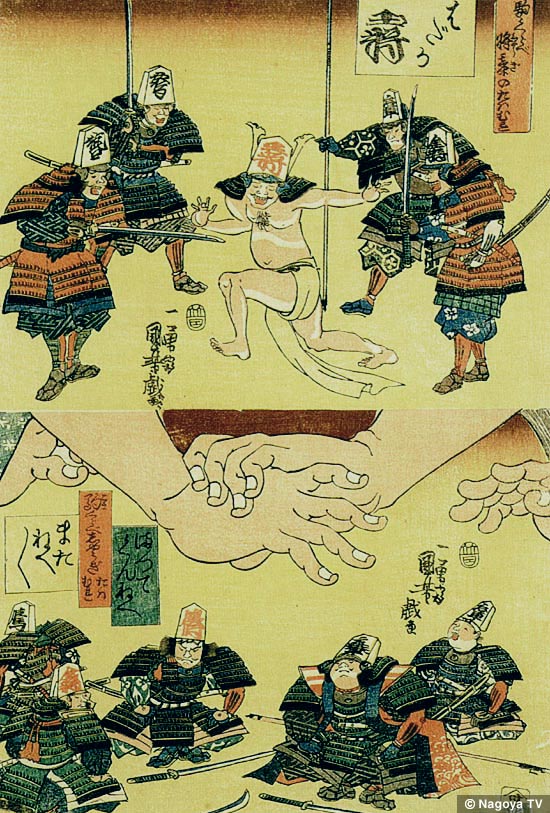
19.駒くらべ将棋のたはむれ はだか王将・まってくんねへまたねへまたねへ
The naked king: can I take that back? No you can't, from the series:"Comparing sides in a friendly game of Shogi"
歌川国芳 KUNIYOSHI
擬人化された将棋が主人である。指し手の具合によって将棋の駒の表情が変えられているのが面白い。
The subjects are personified Shogi pieces. It is funny the way the expression on the faces of the pieces have been changed depending on who's move it is.
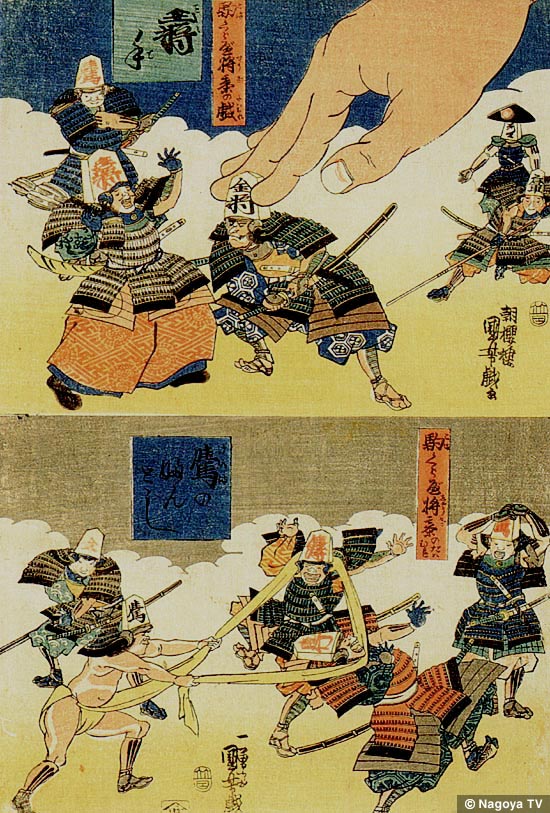
20.駒くらべ将棋のたはむれ 王将手・ 桂馬のふんどし
Check mate and the Keima's (Knight's) underwear, from the series:"Comparing sides in a friendly game of Shogi"
歌川国芳 KUNIYOSHI
戯画を描かせたら天下一品。国芳の発想は汲めども尽きない。将棋の駒を人に見立て、それをガリバーのような実物の人間があやつるという趣向。
If drawing humorous prints, they are works that are second to none. Kuniyoshi's imagination is a bottomless pit. It is a plot in which the Shogi pieces resemble people and a human, like the giant Gulliver, controls them.

